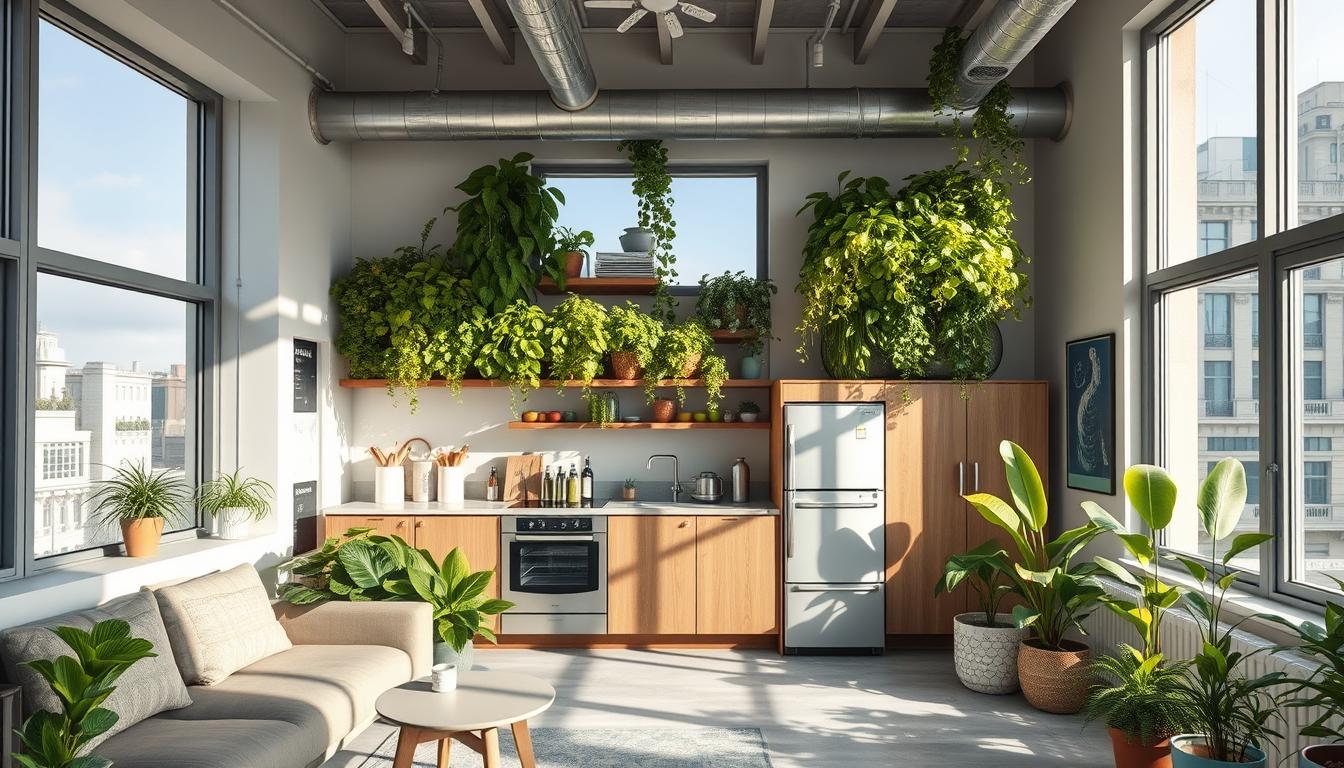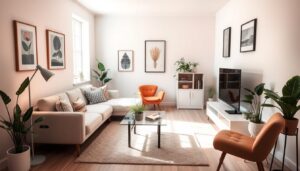In today’s world, more people are living in cities. This means we need to focus on making apartments eco-friendly. The idea of “small space, big impact” shows how we can make a difference with smart design.
Designing apartments sustainably is not just about looks. It’s about saving energy, using resources wisely, and adding green features. By living in an eco-friendly apartment, we help the planet and make our homes better for us.
Understanding Sustainable Design Principles for Urban Living
Urban living is changing fast, and sustainable design is key. This part looks at the main points, how it helps the planet, and the good things it brings to city homes.
Key Elements of Eco-Friendly Apartment Design
Eco-friendly apartments use smart energy systems, save water, and use green materials. These choices help people live greener and feel better about their homes.
The Environmental Impact of Urban Housing
City homes affect the environment a lot. Things like energy use, water, and trash add up. Knowing this helps us make homes that are kinder to the planet.
Sustainable Design Benefits for Apartment Dwellers
Living in green apartments has many perks. People save money, breathe cleaner air, and feel good about helping the planet. It’s a win-win for everyone.
| Eco-Friendly Design Elements | Environmental Impact Reduction | Sustainable Design Benefits |
|---|---|---|
|
|
|
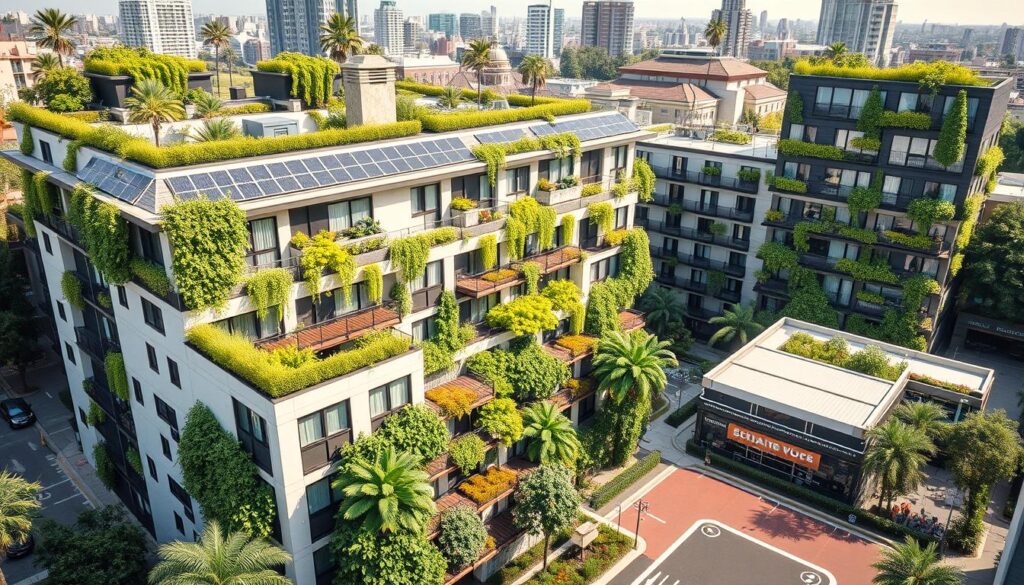
“Sustainable design is not just about reducing environmental impact; it’s about creating spaces that enhance the well-being of the people who live in them.” – Jane Jacobs, urban theorist
By following urban sustainability, eco-friendly design elements, and environmental impact reduction, city dwellers can help the planet. They also get to enjoy the perks of living in a modern city.
Space-Saving Solutions for Modern Apartment Living
In urban areas, space is often limited. Designers have come up with compact living solutions to make the most of small spaces. These ideas help make modern apartments more livable.
Multifunctional furniture is key in saving space. These pieces do more than one thing, saving floor space and adding style. Think of sofas that turn into beds or coffee tables with hidden storage.
Efficient storage solutions also play a big role. They keep your space tidy and looking good. Things like smart shelving, built-in cabinets, and custom closets help keep things organized.
| Space-Saving Furniture | Efficient Storage Solutions |
|---|---|
|
|
By using compact living, multifunctional furniture, and efficient storage ideas, you can make your apartment better. It’s all about finding the right balance. This way, your space looks good and works well.
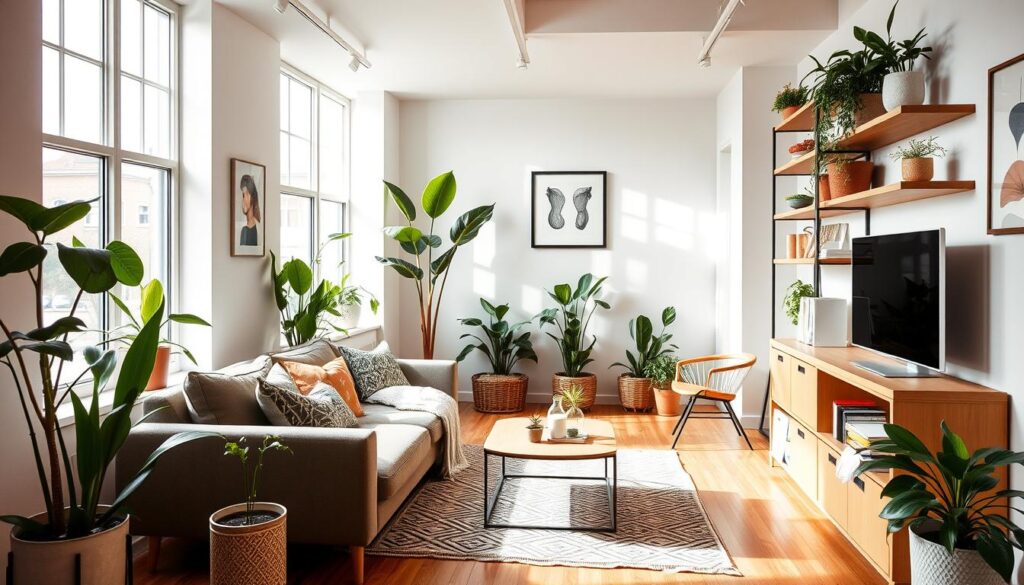
Energy-Efficient Systems and Smart Technology Integration
Modern apartment living is changing with smart home tech and energy-saving systems. These innovations help us live more sustainably. They make our homes smarter and more eco-friendly.
Smart Home Automation for Sustainability
Smart home tech has grown a lot, offering ways to save energy and reduce waste. Smart home automation lets people control lights, temperature, and appliances easily. This helps use less energy and saves resources.
Energy Monitoring and Management Systems
Energy management systems give us real-time energy use data. This helps us make better choices to use less energy. These systems analyze data and suggest ways to save more.
Efficient HVAC Solutions for Small Spaces
In small apartments, efficient HVAC systems are key. New tech like mini-split systems and heat pumps control the climate well. They use less energy and are better for the planet.
Using smart home tech and energy-saving systems makes living better and greener. It’s a step towards a more sustainable future.
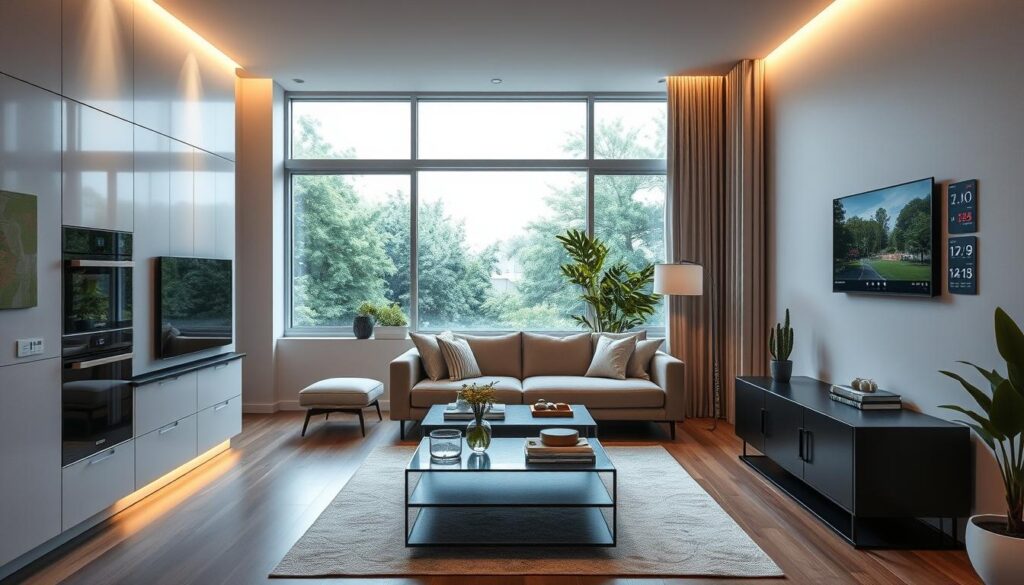
Sustainable Materials and Finishes for Interior Design
Creating an eco-friendly apartment doesn’t mean you have to give up style or comfort. You can make a stylish home that also cares for the planet. Use sustainable materials and non-toxic finishes to do this. Options like recycled and renewable resources, and low-VOC paints, help make your space green.
For flooring, think about bamboo, cork, or reclaimed wood. These materials are not only good-looking but also better for the environment than usual choices. For walls, try natural fiber wallpapers, clay plasters, or eco-friendly paints. These choices reduce harmful chemical release.
| Sustainable Material | Benefits |
|---|---|
| Bamboo Flooring | Rapidly renewable, durable, and biodegradable |
| Cork Flooring | Harvested from the bark of cork oak trees without harming the trees, hypoallergenic, and insulating |
| Reclaimed Hardwood | Reduces waste, preserves natural resources, and adds unique character to a space |
| Natural Fiber Wallpapers | Made from renewable materials like jute, sisal, or seagrass, and often biodegradable |
For furniture, look for items made from recycled or renewable materials. This includes reclaimed wood, organic cotton, or bamboo. These choices are better for the planet and add elegance to your home.
“Sustainable design is not just about being eco-friendly; it’s about creating spaces that are beautiful, functional, and considerate of the planet.” – Jane Doe, Sustainable Interior Designer
Choosing eco-friendly materials and finishes can turn your apartment into a green haven. You don’t have to lose style or comfort in the process. Making your home sustainable is a journey that brings both beauty and benefits to the planet.
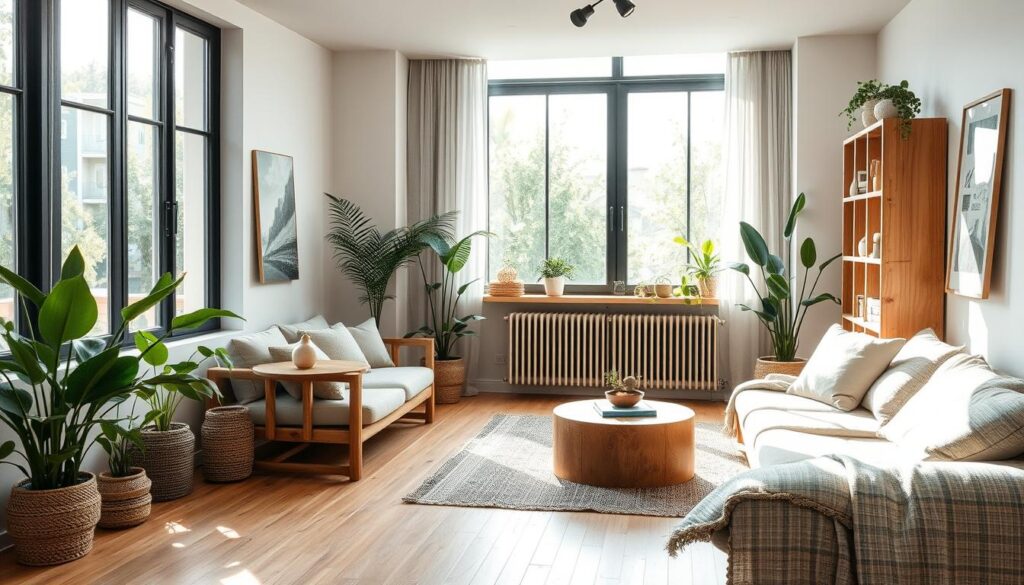
Maximizing Natural Light and Ventilation
In the quest for green living, using natural light and air is key. Daylighting and natural ventilation help cut down energy use. They also make homes healthier and more comfy.
Window Placement and Design Strategies
Where you put windows is very important. Big windows, bay windows, or skylights let in more light. Also, windows facing the wind help cool your home without air conditioning.
Passive Solar Design Techniques
Passive solar design makes the most of sunlight and air. It uses the sun’s path and the building’s shape to control temperature. This way, you can use less energy.
| Daylighting Strategies | Natural Ventilation Techniques | Passive Solar Design Principles |
|---|---|---|
|
|
|
Using these daylighting, natural ventilation, and passive solar design ideas makes homes better. They are comfy, save energy, and connect with nature.
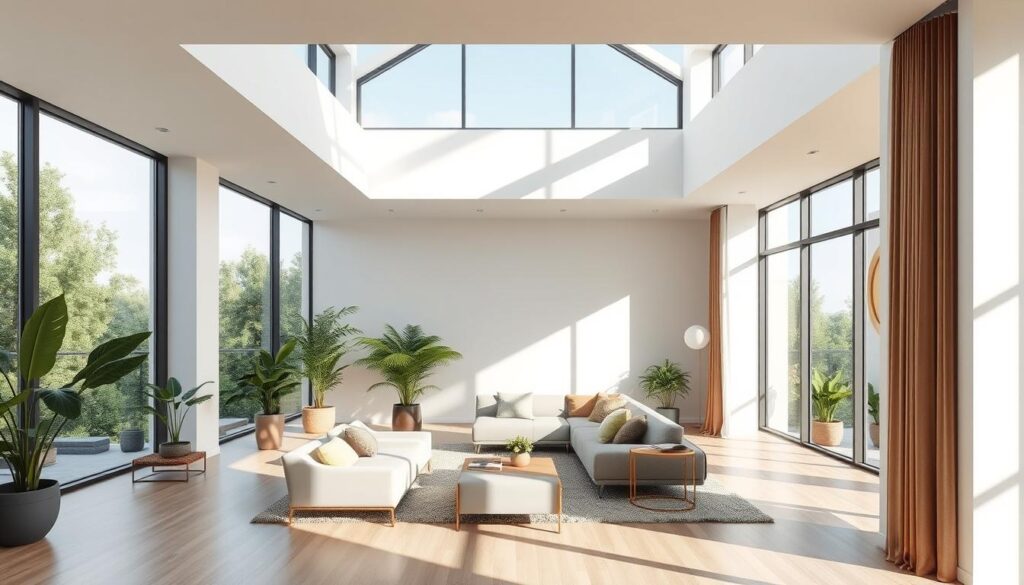
Small Space, Big Impact: Sustainable Design for Apartments
In the quest for apartment sustainability and eco-friendly urban living, green design plays a huge role. By carefully adding sustainable ideas to small spaces, apartment dwellers can help the environment a lot.
At the heart of this effort is the belief that apartment sustainability is doable. With smart design and new tech, people living in apartments can cut down their carbon footprint. They also get to enjoy the perks of green design impact.
Things like energy-saving systems, smart homes, and green materials make a big difference. Adding vertical gardens is another great idea. These eco-friendly urban living steps can change things for the better. By using these ideas, apartment folks can help make cities greener and set a good example for everyone.
“The greenest building is the one that is never built.” – Carl Elefante, Past President of the American Institute of Architects
This saying highlights the value of making the most of what we already have. Instead of always building more, we can make our apartments better and greener. This way, we can make cities more sustainable and strong.
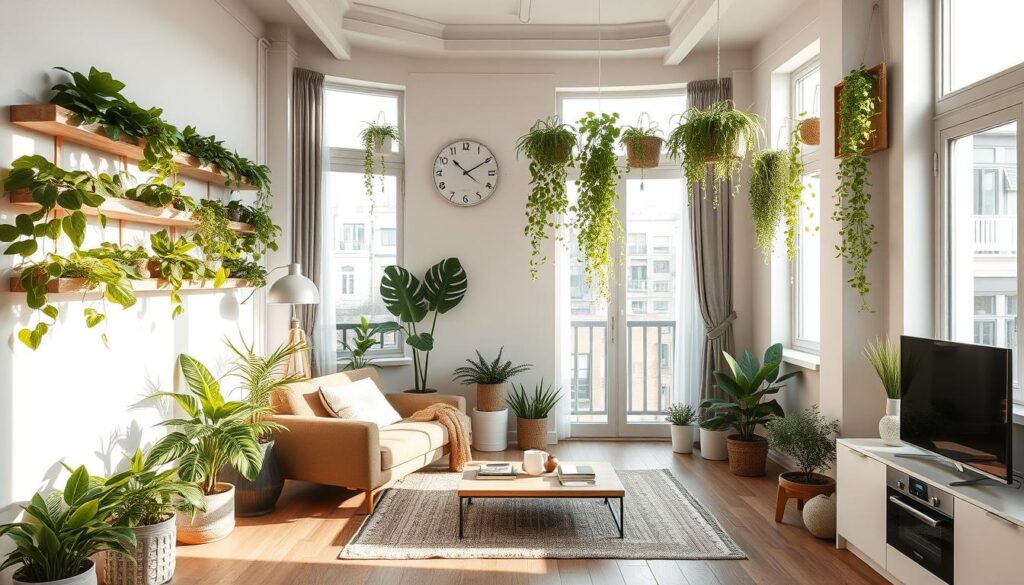
The goal of apartment sustainability is more than just personal choices. It’s about working together. When people living in apartments choose sustainable design, the effect is huge. It helps shape the future of city living and makes tomorrow greener.
Green Building Certifications for Apartment Renovations
Making apartments sustainable is key today. If you’re renovating, look into green certifications. LEED and Energy Star are top choices.
LEED Certification Requirements
LEED (Leadership in Energy and Environmental Design) is a global standard for green buildings. To get LEED for your renovation, you must meet strict criteria. This includes energy use, water saving, air quality, and material choices.
Energy Star Standards for Residential Spaces
The Energy Star program helps homes use less energy. It’s run by the EPA and the Department of Energy. Using Energy Star products can cut down on energy use and costs.
Choosing green certifications for your renovation shows you care about the planet. It also makes your apartment more valuable. Focus on LEED and Energy Star to make your space eco-friendly.
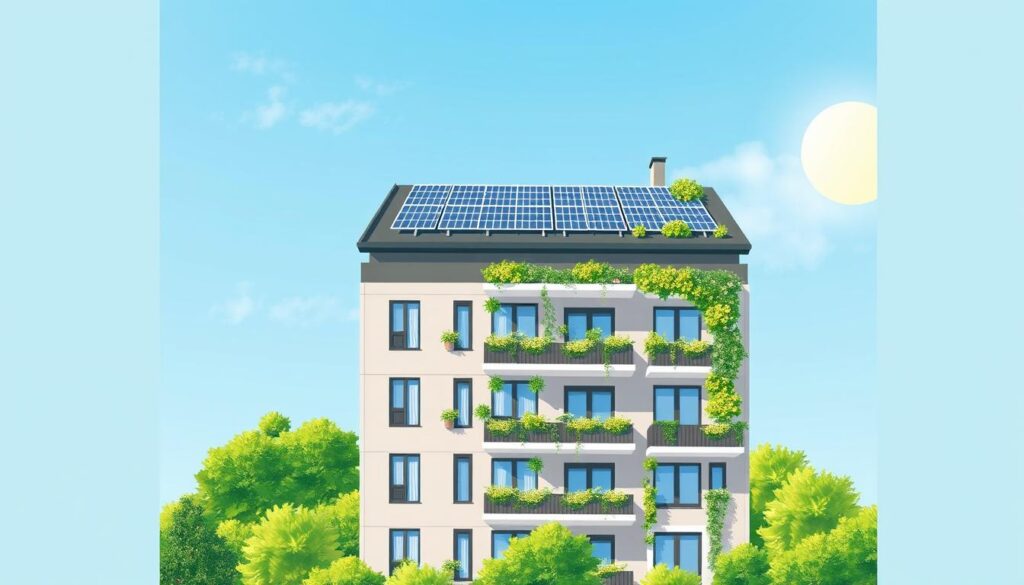
“Sustainable design is not just about the environment – it’s about creating spaces that are healthier, more comfortable, and more efficient for the people who live in them.”
Water Conservation Strategies for Urban Apartments
Living in an urban apartment doesn’t mean you can’t be green. There are many ways to save water and cut down on bills. Simple changes and advanced systems can greatly reduce water use.
Water-Efficient Fixtures
One simple way to save water is to use water-efficient fixtures. Low-flow showerheads, faucets, and toilets use less water but still work well. They help you save water without giving up quality.
Greywater Systems
Greywater systems are another smart choice. Greywater comes from sinks, showers, and washing machines. It’s clean enough for flushing toilets or watering plants, cutting down on fresh water use.
Rainwater Harvesting
Rainwater harvesting is also great for saving water. It collects rainwater for plants or flushing toilets. This way, you use free, clean water instead of tap water.
| Water Conservation Strategies | Benefits |
|---|---|
| Water-Efficient Fixtures | Reduced water usage, lower utility bills |
| Greywater Systems | Recycling of wastewater, reduced freshwater demand |
| Rainwater Harvesting | Utilization of a free, renewable water source |
Using these strategies together can really help the environment. Plus, you’ll save money and live more sustainably.
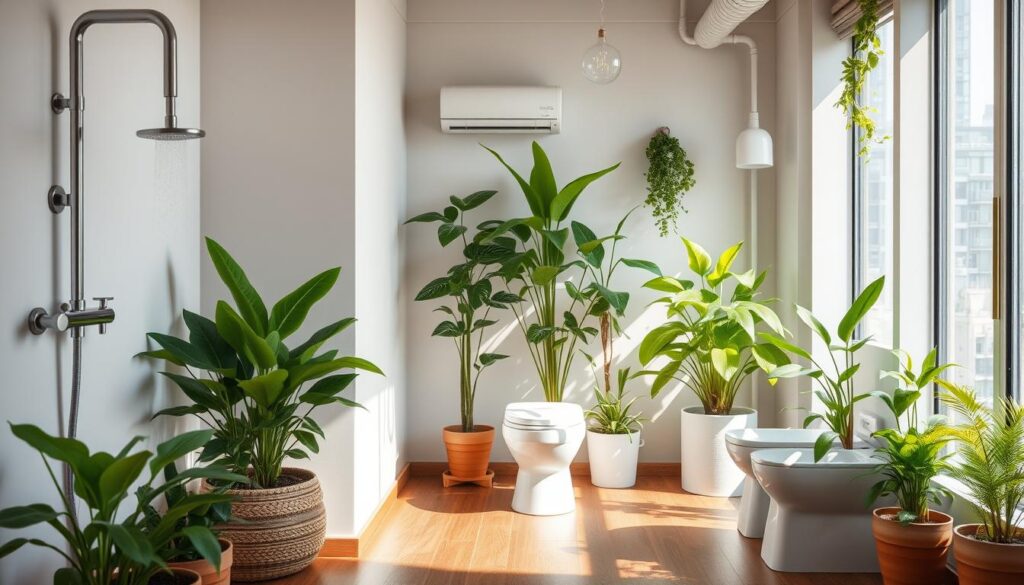
Vertical Gardens and Indoor Plant Integration
Vertical gardens and indoor plants are becoming popular for sustainable living in apartments. They make small spaces look better and offer many benefits. These benefits match the ideas of biophilic design.
Living Walls and Their Benefits
Living walls, or green walls, bring nature inside. They improve indoor air quality by removing pollutants and adding oxygen. They also help keep temperatures steady, reduce noise, and create a calming, nature-inspired ambiance.
Plant Selection for Small Spaces
- Choosing the right plants is key for vertical gardening in apartments. Pick compact, easy-to-care-for plants like succulents, air plants, and vines.
- Look for plants that clean the air, such as English ivy, peace lilies, and snake plants. They help make the air healthier.
- Choose plants that do well in different light conditions. This way, your vertical garden will thrive in any space.
By adding vertical gardens and the right indoor plants, apartment dwellers can make a space that’s good for both body and mind.
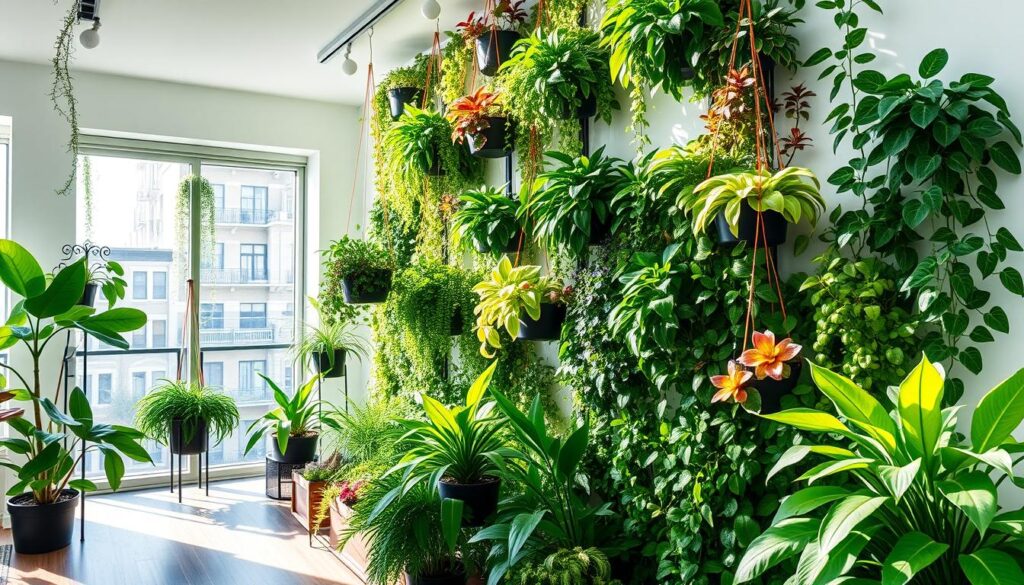
Waste Management and Recycling Solutions
Living sustainably in apartments means managing waste well and recycling. Composting systems turn food waste into fertilizer, helping the environment. People living in apartments can also use recycling strategies to lessen their impact on the planet. This leads to a zero-waste living lifestyle.
Countertop composters are great for city folks. They turn food waste into soil for plants. These small systems help keep organic materials out of landfills and support a green economy.
- Explore the latest composting systems designed for small-space living
- Learn about the benefits of recycling strategies in apartment complexes
- Discover practical tips to embrace a zero-waste living approach
Recycling in apartments can really help. It’s about using recycling strategies and teaching others. By sorting recyclables and cutting down on waste, we can all help the planet.
“Recycling is the process of converting waste materials into new materials and objects. It is an essential component of modern waste management and is the third component of the ‘Reduce, Reuse, Recycle’ waste hierarchy.”
Adopting a zero-waste living lifestyle is even better. It means buying less, reusing more, and recycling. Apartment folks can start by buying items with less packaging. They can also find new uses for things they already have.
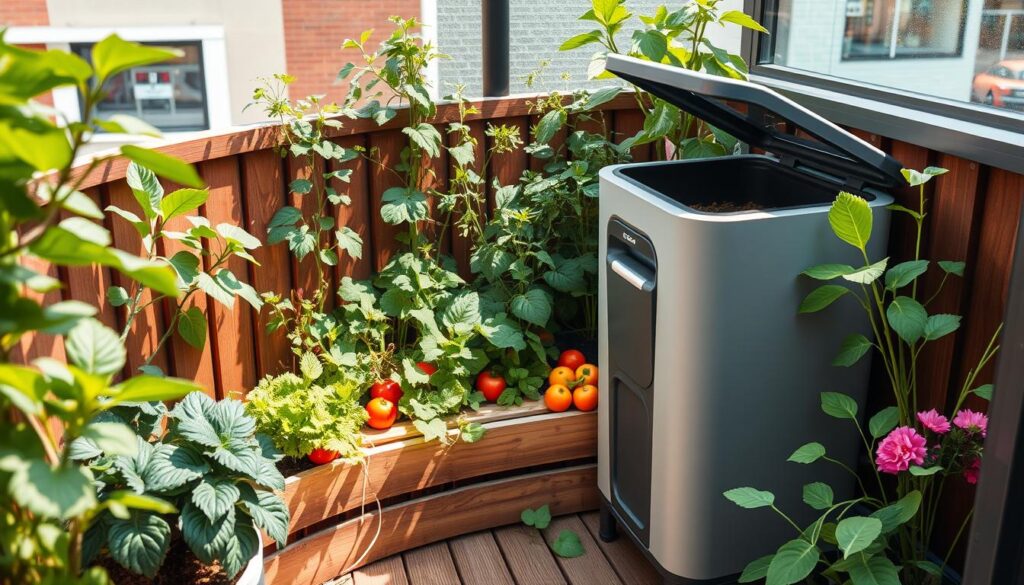
Using composting systems, recycling strategies, and aiming for zero-waste living helps a lot. Even in small spaces, apartment dwellers can make a big difference for the environment.
Cost-Effective Sustainable Upgrades for Renters
Living sustainably as renters might seem hard because you can’t make big changes. But, there are many renter-friendly upgrades and affordable sustainability options. These can make a big difference without needing to renovate a lot.
Temporary Modifications for Energy Efficiency
Renters can try temporary eco-solutions to save energy. Simple actions like putting insulating window film on, using smart thermostats, and changing to LED bulbs can save a lot of energy. You don’t need to make any permanent changes.
- Insulating window film: This film stops heat from passing through windows. It helps keep your apartment cooler in summer and warmer in winter.
- Programmable thermostats: These thermostats let you set the temperature automatically. They save energy by adjusting the heat or air conditioning when you’re not home.
- LED lighting: LED bulbs use much less energy than old bulbs. They can cut your lighting costs by up to 75%.
Budget-Friendly Green Solutions
Renters can also find budget-friendly green solutions to live more sustainably. Upgrades like low-flow showerheads, water-saving faucet aerators, and rechargeable batteries are easy on the wallet. They help you live greener.
- Low-flow showerheads: These showerheads use less water. They can save thousands of gallons of water every year.
- Faucet aerators: These small devices attach to faucets. They can cut water use by up to 30% without losing any performance.
- Rechargeable batteries: Using rechargeable batteries for your devices can greatly reduce waste and save resources.
By choosing these renter-friendly upgrades and affordable sustainability options, renters can really help the environment. They also get to enjoy the benefits of living in a more eco-friendly way.
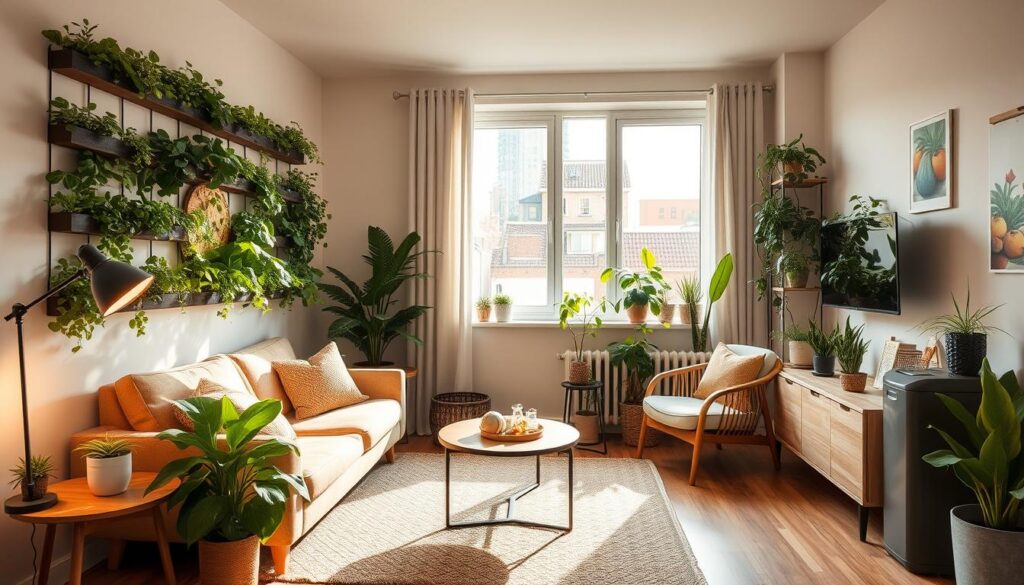
Multi-Functional Furniture and Storage Design
Living in a small apartment calls for smart furniture and storage. Items like Murphy beds and modular shelves help make the most of every inch. They also cut down on waste by reducing the need for extra furniture.
Modular furniture lets you change your space as you need. You can add or remove parts to fit your lifestyle. Options like wall shelves and hidden spots keep your home tidy and organized.
Adding smart home tech to your furniture takes it to the next level. Features like touch-activated storage and motorized beds save space and energy. This approach makes small apartments both cozy and eco-friendly.
Conclusion
Adopting sustainable housing design is crucial in the modern, urbanized environment. Eco-friendly materials and energy-efficient technologies are only two examples of how small spaces may significantly affect both the environment and human health. We can design homes that are both fashionable and environmentally friendly by implementing techniques like utilizing multipurpose furniture, integrating smart technology, and optimizing natural light.
Sustainable living aims to improve comfort, save money, and promote a healthy way of life in addition to lessening its negative effects on the environment. Every step toward greener living counts, whether it’s through renter-friendly modifications, water-saving fixtures, or vertical plants. When taken as a whole, these initiatives help create a more sustainable urban future in addition to helping individual apartment residents. We can significantly improve our lives and the environment by rethinking small areas via thoughtful design.

